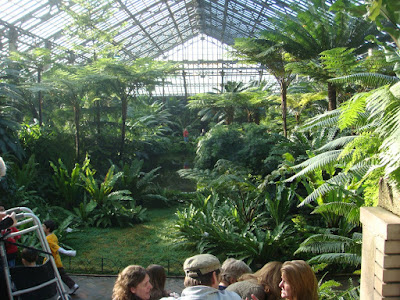It was a bustling crowd at Garfield Park on this sunny January day. We have long ago figured out to leave the coats in the car and make a mad dash for the door. It's too much of a burden to lug our big winter parkas along and we tough Northerners can handle a few minutes of frozen air. My husband and I love to take pictures, so it always takes a few minutes for the cameras to adjust to the wonderful moist air of the Palm Room. Walking into the huge haystacks of glass and breathing all that hyper-oxygenated air is a beautiful thing! I can feel my skin relax in the dense humidity. Not to mention the incredible plants.
I will be the first person to tell you I specialize in zone 5 outdoor flora. Don't ask me about how to care for your houseplants. I can give you a general answer. Ask me about the differences between all the hydrangeas, and I'm yours for an hour. Yet, come January/February, I need to be in a conservatory. It reminds me that there are bright flowers, green leaves, and growing things somewhere. I can plop myself down in the Fern Room and pretend it's Brazil. The Oak Park conservatory has live birds and the most extraordinary Ponderosa lemon tree. It also has a coat rack!
Here are a few pictures from the couple hundred I took today.
The Palm Room at Garfield Park
The azalea show just started.
The Fern Room at Garfield Park and some of the folks hanging out on the steps.
Oak Park Conservatory.
Datura in full bloom.
The Ponderosa lemon is flowering and fruiting. The lemons are about the size of softballs, but I understand from the staff that they don't taste like much.











